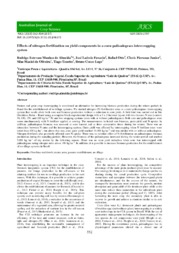Effects of nitrogen fertilization on yield components in a corn-palisadegrass intercropping system.
Effects of nitrogen fertilization on yield components in a corn-palisadegrass intercropping system.
Author(s): ALMEIDA, R. E. M. de; FAVARIN, J. L.; OTTO, R.; PIEROZAN JUNIOR, C.; OLIVEIRA, S. M. de; TEZOTTO, T.; LAGO, B. C.
Summary: Pasture and grain crop intercropping is considered an alternative for increasing biomass production during the winter periods in Brazil for the establishment of no-tillage systems. We studied nitrogen (N) fertilization rates in a corn-palisadegrass intercropping system that would allow both corn and biomass production without a reduction in corn yield. A field trial was carried out in São Desidério, Bahia - Brazil using a complete block experimental design with a 5 x 2 factorial layout with two factors: N rate (control, 50, 100, 150, and 200 kg ha-1 N) and two cropping systems (corn with or without palisadegrass). Both corn and palisadegrass were sown simultaneously with N fertilizer applied at sowing. The measurements included corn biomass, grain yield and N uptake. In addition, palisadegrass biomass was assessed at corn harvest and at three consecutive times during the winter. There was an interaction between N rates and the intercropping system. Grain yield was affected by intercropping when N fertilizer rates were lower than 100 kg ha-1, but above that rate, corn grain yield reached 10,000 kg ha-1 and was similar with or without palisadegrass. Nitrogen fertilizers also positively affected corn N uptake. There was no residual effect of N fertilization on palisadegrass biomass production during the sampling periods. However, the biomass of the palisadegrass increased during the winter period and reached 5,000 kg ha-1 of dry matter by the following season. There was no corn yield reduction when corn was intercropped with palisadegrass using nitrogen rates above 100 kg ha-1. In addition, it is possible to increase biomass production for the establishment of no-tillage systems in Brazil.
Publication year: 2017
Types of publication: Journal article
Observation
Some of Embrapa's publications are published as ePub files. To read them, use or download one of the following free software options to your computer or mobile device. Android: Google Play Books; IOS: iBooks; Windows and Linux: Calibre.
Access other publications
Access the Agricultural Research Database (BDPA) to consult Embrapa's full library collection and records.
Visit Embrapa Bookstore to purchase books and other publications sold by Embrapa.

